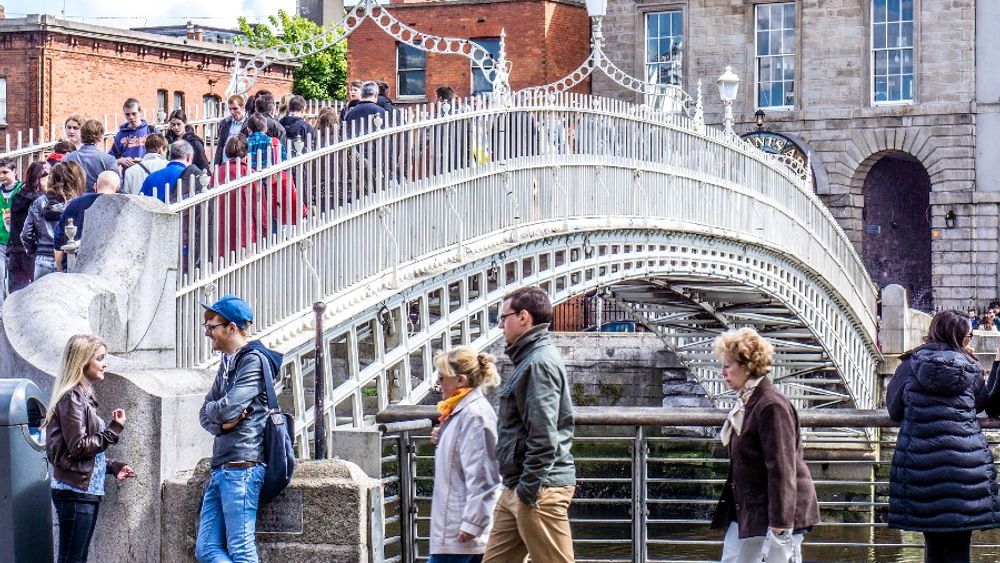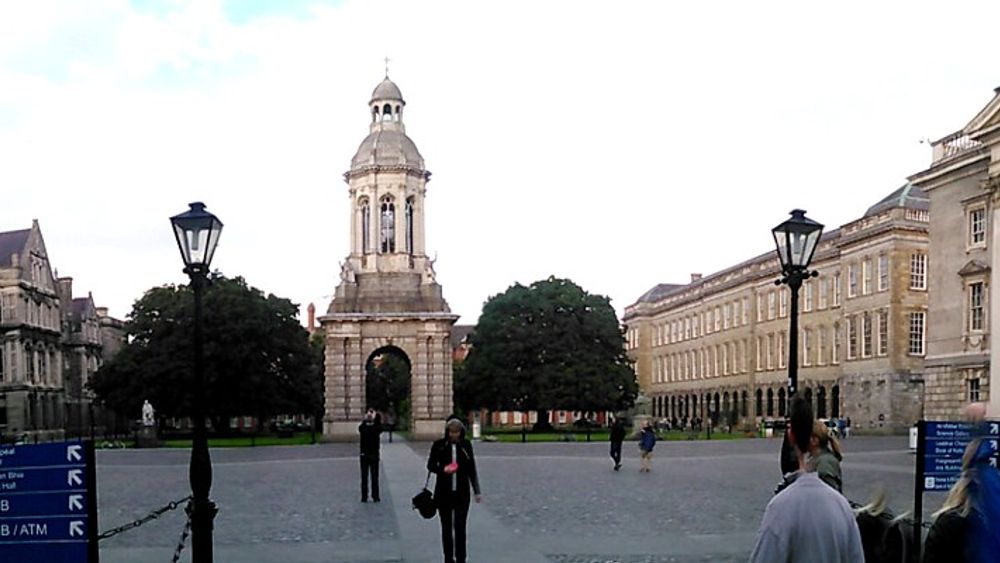Welcome to Dublin: Private 2.5-hour Introductory Walking Tour
3 hours
From 09:00
Group 1+
3 hours
09:00
12
What you'll do
Explore the highlights of central Dublin on this fascinating private welcome tour of Ireland's vibrant capital city. Situated on the Liffey River and the Irish Sea, surrounded by mountainous countryside, Dublin has a history spanning over a thousand years. The city has so much to offer from its beautiful architecture and famous literary heritage to historic tales of the Vikings and Normans, the long fight for independence from the British, and its modern contemporary culture with picturesque cobbled streets, cafes, pubs, and general 'good craic!' On your private walking tour, you will: Explore the highlights of central Dublin on this fascinating private welcome tour of Ireland's vibrant capital city. Situated on the Liffey River and the Irish Sea, surrounded by mountainous countryside, Dublin has a history spanning over a thousand years. The city has so much to offer from its beautiful architecture and famous literary heritage to historic tales of the Vikings and Normans, the long fight for independence from the British, and its modern contemporary culture with picturesque cobbled streets, cafes, pubs, and general 'good craic!' On your private walking tour, you will: Meet your guide by the James Joyce Statue, a bronze statue in tribute to the Irish novelist;Pass by the General Post Office - one of Dublin's grandest Georgian buildings that served as the Headquarters of the Easter Rising of 1916; Walk down the historic O'Connell's Street, the major thoroughfare of the city - renamed in 1924 after the Nationalist leader Daniel O'Connell whose statue stands proudly at the end of the street;Stroll along the banks of the Liffey, crossing over the Ha'Penny Bridge, a pedestrian cast iron bridge built in 1816, with wonderful views; Stop inside the famous Temple Bar - popular with artists and poets, established in 1840 it is famous for its collection of 450 different types of whisky; Wander down Parliament Street, and stop to admire the magnificent Georgian architecture of City Hall built in the 1760s - a popular wedding venue and working civic centre;Arrive outside the impressive Dublin Castle in the historic heart of the city - one of the most important buildings in Irish history built in the 13th century; Pass the famously buxom bronze statue of Molly Malone, the fictional star of a popular Irish song; Enter the grounds of the historic and awe-inspiring Trinity College complex where you'll learn all about this prestigious university, see the Parliament Square with the famous Campanile (the bell tower), admire the old library - famous for housing the 9th century Book of Kells and the Sphere within a Sphere sculpture by Arnaldo Pomodoro; Walk past other historic buildings to St. Stephen's Green, a historic tranquil and picturesque park in the centre of Dublin, famous for its role in the Easter Rising, and your tour in the historic centre of Dublin, at a local pub with a pint of Guinness or hot beverage of your choice on us! Enjoy this welcome to Dublin private tour with an expert local guide, the perfect way to get your bearings and to get to know the historic heart of Ireland's vibrant capital city. You'll visit all the highlights of the city including the General Post Office on O'Connell's Street, the lively Temple Bar, Parliament Street, City Hall, historic Dublin Castle and Trinity College, and St Stephen's Green. You'll learn all about daily life in modern-day Dublin, as well as its long history dating back over 1000 years, as you walk along its quaint cobbled streets, passing beautiful, grand Georgian buildings, crossing the Liffey River into the fun, artsy and bohemian district of Temple Bar. At Dublin Castle, the historic heart of the city and still a working governmental complex today, you'll hear about the Vikings, and Normans, and the country's long struggle for independence from the English. One of the most important buildings in Irish history, you'll be able to admire its 13th-century tower and surviving medieval structures. Dublin has witnessed everything from the Great Famine to the fight for Irish Freedom; today it's a leading country in the European Union, a thriving modern city with the annual St Patrick's Day Parade that attracts millions of revellers to the city to enjoy Irish folk songs, pints of Guinness and traditional Cèilidh dancing! On this tour, you'll also visit the prestigious Trinity College - and hear about the academic excellence, and poetic and literary appeal of the city - which was the home of many luminaries like James Joyce, W.B. Yeats, and Oscar Wilde. After a pretty stroll through St Stephen's Park, a popular green space in the city centre - with lots of history, your tour ends with a drink in a local pub on us, where you can ask your local guide anything about the city over a pint of Guinness or any drink of your choosing! Enjoy this welcome to Dublin private tour with an expert local guide, the perfect way to get your bearings and to get to know the historic heart of Ireland's vibrant capital city. You'll visit all the highlights of the city including the General Post Office on O'Connell's Street, the lively Temple Bar, Parliament Street, City Hall, historic Dublin Castle and Trinity College, and St Stephen's Green. You'll learn all about daily life in modern-day Dublin, as well as its long history dating back over 1000 years, as you walk along its quaint cobbled streets, passing beautiful, grand Georgian buildings, crossing the Liffey River into the fun, artsy and bohemian district of Temple Bar. At Dublin Castle, the historic heart of the city and still a working governmental complex today, you'll hear about the Vikings, and Normans, and the country's long struggle for independence from the English. One of the most important buildings in Irish history, you'll be able to admire its 13th-century tower and surviving medieval structures. Dublin has witnessed everything from the Great Famine to the fight for Irish Freedom; today it's a leading country in the European Union, a thriving modern city with the annual St Patrick's Day Parade that attracts millions of revellers to the city to enjoy Irish folk songs, pints of Guinness and traditional Cèilidh dancing! On this tour, you'll also visit the prestigious Trinity College - and hear about the academic excellence, and poetic and literary appeal of the city - which was the home of many luminaries like James Joyce, W.B. Yeats, and Oscar Wilde. After a pretty stroll through St Stephen's Park, a popular green space in the city centre - with lots of history, your tour ends with a drink in a local pub on us, where you can ask your local guide anything about the city over a pint of Guinness or any drink of your choosing! Slàinte!Slàinte!
What's Included
A friendly, professional English-Speaking tour guide for your own private group
A pint of Guinness or a hot beverage of your choosing.
What's not included
Hotel pick up and drop off
Food and additional drinks
Gratuities
Meeting Points
Your guide will meet you by the James Joyce Statue, 2 N Earl St, North City, Dublin 1, D01 K5W5, Ireland
Venue Information
General Post Office
A National Icon
There are few greater symbols of the dramatic history of Irish Republicanism than Dublin’s General Post Office. Inaugurated on the 1st of June 1818, the magnificently fronted building was famously the headquarters of the Easter Rising in 1916. Also known as the Easter Rebellion, the movement was a bold attempt to end Britain’s rule of Ireland while the majority of its military forces were engaged in the First World War.
Though the rebellion was crushed within a week by vastly superior numbers and firepower, and its ringleaders executed, the event was instrumental in reinvigorating Irish republicanism and is considered a landmark event in bringing about the end of British rule. Walking around the GPO today, you cannot help but be drawn into the history of the place as you examine the bullet and shrapnel holes that pepper the outer walls. The year 2016 marks the centenary of the rising, and a variety of events and exhibitions have been planned across the city to commemorate it.
Stone and Fire
Even without its impact on the course of Irish history, the GPO would still easily merit a visit. One of the capital’s great Georgian buildings, its 67-metre wide granite façade immediately catches the eye as you stroll down O’Connell street, the city’s main thoroughfare. A beautiful Ionic portico consisting of six fluted columns serves as the building’s centerpiece, summited by statues of Mercury, Fidelity and Hibernia on the pediment. Though a large part of the building was destroyed by fire following the heavy shelling of 1916, the grandeur and national pride contained within this old post office remains untarnished.
Ha’penny Bridge
2016 marks the 200th anniversary of the opening of the pretty Ha’penny bridge, which is arguably Dublin’s most photographed structure. Without doubt it is the most popular of the River Liffey’s 20 bridges, with an average of 30,000 pairs of feet crossing it each day – compared with just 450 when it first opened.
From Boats to Bridges
In the early 1800s the only way to cross the river was by using one of seven ferries, which were dilapidated and often dangerous. The city gave the ferry operator, William Walsh, an ultimatum: either fix the ferries, or build a bridge. He chose the latter option, and was given the right to charge a halfpenny toll to each person who crossed it, from which the bridge takes its name. Officially called the Liffey bridge, it was the only pedestrian bridge to span the river until the opening of the Millenium Bridge in 1999.
These days, the bridge has come a long way from its businesslike origins. The toll was scrapped in 1919, and in its place has grown an irresistible romanticism that has won the affection of an entire city. Buskers strum hopefully for the passersby, young couples stroll along hand in hand and pretty period lanterns gently illuminate the scene as dusk falls. In fact, the bridge’s romantic air became rather too much for it in 2013, when the city council was forced to remove over 300kg of “love locks” – padlocks bearing a couple’s names and attached to the bridge – citing a risk of structural failure.
Temple Bar
No trip to Dublin would be complete without a pint of Guinness, and the buzzing Temple Bar area is the perfect place to find one. Its cobbled streets, liberally hung with all manner of traditional Irish decorations, are home to a wide variety of quirky shops, stalls, and of course the numerous pubs and bars for which the area is renowned. While the district is perhaps not quite as authentic in its Irishness as its “cultural quarter” promotions might lead you to believe, there is no mistaking the spirit of the Emerald Isle which adds a unique twist to everything you pass.
A Colourful History
In the Middle Ages this area was little more than a suburb of Dublin, outside the city walls, and for three centuries it suffered badly at the hands of raiders. The 17th Century provided some rare respite for this historically troubled spot, as much of the land was converted into gardens for wealthy English families. After another hundred years, however, it had become Dublin’s centre for prostitution, and continued to experience decline and decay until the 1980s, when plans for a large new bus terminus drove down the area’s rent prices. This in turn caused an influx of young people, small businesses and galleries. The bus station scheme was eventually abandoned, and Temple Bar has thrived ever since.
Something for Everyone
Modern Temple Bar hums with an atmosphere driven by live music, good beer and delicious traditional food. The Oliver St. John Gogarty, The Porterhouse and The Auld Dubliner are some of the more famous spots, but there are plenty of lower-key hangouts if you are willing to explore a bit. Temple Bar Square hosts a book market every weekend, while the recently renovated Meetinghouse Square houses a weekly food market on Sundays.
Trinity College
Walking through the grounds of Ireland’s oldest university, it is easy to forget that you are in the middle of a modern capital city. Spread out over almost 50 acres, its wide-open grassy spaces and ancient quads provide a welcome break from the bustle of central Dublin and manage to combine a friendly, student-driven atmosphere with a strong sense of history. Elizabeth I founded Trinity in 1592 as part of an effort to prevent promising young Dubliners heading to Europe to pursue a university education. Since then, it has developed into one of the world’s most prestigious academic institutions, and can boast alumni such as Oscar Wilde, Francis Bacon and Jonathon Swift.
The Pages of History
Foremost among Trinity’s attractions is its library. A masterpiece of 17th century architecture, its original building would once have towered over the rest of the university. Even now, surrounded by building of comparable size, the old library dominates the view of the university from Nassau Street. Inside are housed no fewer five million books. The most famous of these is the Book of Kells, a 1200-year-old illuminated gospel manuscript widely regarded as one of Ireland’s finest historical artefacts. The old library also features the gorgeous Long Room, whose polished two-storey shelves stretch back a full 65m, interspersed with marble busts of historical figures associated with the university.
Bad luck of the Irish
Another of Trinity’s most important structures is the Campanile, a 30m belltower located in the centre of the university campus. Its size and form are impressive from any angle, but beware walking beneath it - legend has it that anyone passing under the tower when the bells begin to ring will be doomed to a lifetime of bad luck.
Dublin City Hall
A Den of Vice
This site next to Dublin Castle at the top of Parliament Street was not always occupied by so prestigious and grand a building as the City Hall. In the mid-1700s a tavern called The Eagle became the sordid hangout of the Earl of Rosse’s infamous Hellfire Club, whose drunken, debaucherous and occasionally diabolical revelries became the stuff of Dublin legend. These days, the sex and satanism have been toned down but the location is no less widely renowned.
A Celebrated Restoration
Designed by Thomas Cooley and completed in 1779, Dublin City Hall marked the introduction to Ireland of the European neoclassical architectural style, and remains an exquisite example of it. When it was converted into a government building in the mid-1800s, the team tasked with overseeing the alterations to the building created a number of unsightly additions to the structure which ruined its overall aesthetic effect. Thankfully, an award-winning restoration program in the early 21st century has returned City Hall to its former Georgian splendour.
Trading Places
After paying a €4 entry fee, you are admitted into the rotunda, a spectacular entrance hall crowned by a large dome, which is supported by 12 marble columns. You can wander between the columns, over the gorgeous floor mosaics and around the ambulatory surrounding the rotunda, and your footsteps will follow those of the merchants who once discussed business in this place over 200 years ago.
In the vaults downstairs there is a multimedia exhibition detailing the history of Dublin from the Anglo-Norman invasion of 1170 to the present day. For an entry of only €2, it is well worth a visit.
Dublin Castle
Dublin Castle is not quite what the name might lead you to expect. Though it does boast an impressive 800-year history, having been commissioned and built by King John of England in the early 13th Century, only the Record Tower now remains of the original stone structure, and it now feels more akin to an 18th Century stately home than a mighty medieval fortress.
England’s stronghold in Ireland
Nevertheless, the castle is certainly worth a visit, if only because its history is in many respects the history of Dublin itself. Its succession of significant historical episodes peaked a century ago during the fierce struggle for Irish independence, which was eventually secured, together with the keys to the castle, in 1922. You can walk through the room where James Connolly, the leader of the 1916 Easter Rising, was kept prisoner tied to a chair prior to his highly provocative execution. During the Anglo-Irish war for independence a few years later, three key IRA members were tortured and killed within the walls of the castle on the evening of that conflict’s “bloody Sunday”.
Visiting the castle today is thankfully not so harrowing. Its spacious grounds are perfect for a stroll on a sunny day, and there is a café to one side for those who want to rest their weary legs. Taking a tour will allow you to see St. Patrick’s Hall, where new Irish presidents are inaugurated. The highlight of your visit should be a trip down to the undercroft of the castle. Accidentally discovered in 1986, it is possible to see an ancient Viking foundation, as well as the remaining dribble of the River Poddle, which once supplied the moat.
St Stephen's Green
Maintained in its original Victorian design, St Stephen's Green is a park beloved by locals.
O'Connell Street
O'Connell Street is the heart of Dublin's thoroughfare - with shopping, pubs, restaurants and historic landmarks, including the old post office.
Molly Malone Statue
Iconic black bronze statue of Molly and her cart of fish.
Gallery


Cancellation policy
A full refund will apply if you cancel more than 48 hours before the activity start time.
No refund is possible if you cancel less than 48 hours before the activity start time.
Get inspired by a world of food
Carefully curated guides, reviews and inspiration by our team of food travellers and critics.




